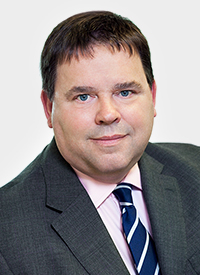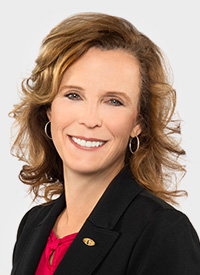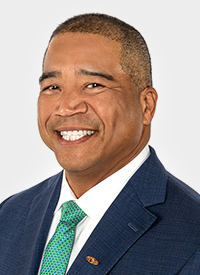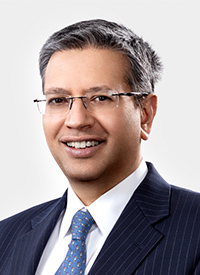
A lot can happen in 80 years. For Crawford & Company, which is celebrating its 80th anniversary, a lot has happened. From the single office Jim Crawford established in 1941, the company has become a global leader and standard-setter in claims.
Crawford®'s evolution and growth can be measured not only in terms of strategic acquisitions and technology development, but also in innovative approaches to claims handling and training for adjusters and nurse case managers.
As much as the insurance industry and clients' expectations have changed during the past eight decades, some things haven't, noted Rohit Verma, chief executive officer of Crawford. "Some of the basic needs of clients are the same. We are in the claims industry. When we're working with claimants, they've often had one of the worst days of their lives. These claims require a level of empathy, a level of human touch. That's part of our legacy and we feel extremely proud of that.
"Expectations of clients are changing. Digitization has changed every aspect of our lives. We can order a car, groceries, deposit a check, all from our phones. I don't think it's inconceivable or unfair for a consumer to say that's what I expect from my insurance company and my claims as well. They expect responsiveness to be a lot of faster, and we as an industry have to adapt to that," continued Verma. "At Crawford, our purpose hasn't changed, which is to restore and enhance lives, businesses and communities. How we restore that life, restore that community, restore that business, is certainly taking a more digital form, which is what consumers are expecting of us now and will going forward."
Even as tools and technology-enabled solutions have introduced new processes, claims is fundamentally a people business, said Bonnie Sawdey, chief people officer for Crawford.
"The introduction of technology-enabled solutions has made a big difference for us and our business. We know that people want and demand those self-service capabilities, but they want it to be easy. We know it's often not easy, so we have to pair that technology with a solution that also allows us to provide an empathetic and caring human interaction in that process, and help us make sure we're managing that claim effectively for our clients and their claimants," she said.
Another thing that hasn't changed is what employees are looking for from their employers. "People want purpose and meaning. They want to feel that they're part of a family. At Crawford, we've been able to do that. We have a very rich history and a long legacy, and I think the Crawford family's involvement and support in our business has helped us provide purpose-driven and meaningful careers. That's one of the reasons why you see long-service tenured employees at Crawford, and our hope is we'll continue to do that."
Benedict Burke, chief client officer, Global Client Development, has seen a significant shift in the claims role over the past years. The focus now is on expertise and new skill sets, as well as regulation.
"The genesis of loss adjusting and claims management can be traced to the need for a generalist view on a loss, particularly around commercial claims. There was a need for a generalist perspective on the event itself and the scope of the losses incurred. Over the years, that role has evolved and expanded considerably. Consistently across the world, we're seeing the need for a broader spectrum of expertise, and the ability to map that expertise precisely to the requirements of the claim event and the type of risk that's being insured.
"One of our key strategies is to seek ways to further deepen our pool of specialty expertise. As a business, we recognized that need pretty early and evolved our scope of expertise through our Crawford Global Technical Services®, where dual-qualified adjusters are now commonplace. They are an essential component of our proposition. And those ‘fixed’ roles are evolving, and we're starting to embrace other skills across the business. We're looking to expand our expertise around areas such as data management, analytics, repair management, medical claims management and marine. The need to grow our industry specialty knowledge reflects a clear shift in the business model, one which has accelerated and will continue to accelerate post-COVID.
"The other area of impact is the need to reflect increasing regulation, both from a Crawford perspective and that of our clients. It is imperative that we maintain a fit-for-purpose framework that enables us to deliver against the regulatory demands of industry bodies and regulators that look at and measure the quality of our service provision against the brand promise that our clients have made. That oversight mandate, which is becoming more relevant to insurers, is going to be a key differentiator. Our clients must be fully confident that the people they entrust claims management to are qualified and committed. I see insurers scrutinizing our capabilities and those of our industry much more stringently and we must ensure that we are fit-for-purpose," he said.
In 1903, the Wright Brothers made the first successful manned flight. Sixty-six years later, two astronauts set foot on the moon. In between those historic events, a remarkable number of technology innovations occurred. In claims, the period since Crawford's founding in 1941 also has seen rapid advances, pointed out Larry Thomas, global president of platforms.
"When I look over the last 80 years and especially the close to 40 years I've been involved at Crawford, it's more the manner in how we process claims that has evolved than the claims themselves. The insurance industry has been evolving with the utilization of technology over our 80-year history. I've witnessed a remarkable journey that Crawford has been on. I've seen us evolve from a paper claims handling process to embracing and leveraging technology a number of ways," he said.
"From the very beginning, everything was pen and paper, for claim reporting. Then we made this big, pivotal transition to having fax machines. I remember the day seeing this box in the corner of the office when we got our first fax machine. It sat there for about two weeks, but ultimately it changed the way claims were reported. Fast-forward to today, we've made the transition to real-time claims systems and the API integration that is connecting us with our clients," Thomas said.
Major advances in claims over the past 40 years include automated estimating and mobile technologies that enable adjusters to efficiently conduct inspections and deliver estimates onsite, Thomas added. "When I started, property adjusters were making hand-written estimates, then they moved to sharing one desktop to convert those estimates in an office. Today, adjusters are equipped with tablets, electronic measuring devices, 3-D scan options, smartphones that enable onsite estimating and other technology tools. I'm sure it makes those of us who have been around awhile feel like dinosaurs, but that's just how fast in a short period of time we've come."
Other claims technology trends Thomas noted include: Digital Desk, a Crawford platform that lets insurers leverage resources for more complex claims; innovative inspection methods, such as virtual inspection and on-demand inspection tools available through Crawford's WeGoLook® division; and tools such as Crawford's Contractor Connection® managed repair solution.
"These are all network solutions that are technology-enabled but driven by digitized platforms that help capture and drive data and analytics that have really made a night-and-day difference over the course of the last 40 years. And there's more to come. We're still in the middle of this technology journey," he said.
Crawford has emphasized employee training almost as long as it has been in business, said Bonnie Sawdey. "One of the founding principles from Jim Crawford was that knowledge and creativity is power. I believe we bring this to life for our adjusters and nurses through a constant review and evolution of our training courses. We've added technical training and we're bringing innovation to those training programs.
"As an example, in our residential property loss adjusting class, we're using 3-D virtual reality scans. These scans allow us to show students a wide variety of different types of losses, to better prepare them when they're out in the field. Our nurses are now training to identify mental illnesses, and make sure we're taking care of the injured workers and that they get the right care. We've also supported our adjusters in helping them obtain their licenses and keep their licenses current with a library of courses that are approved for continuing education credits," Sawdey explained.
Equally important to the technical training, she added, is "we've embedded soft-skills training, such as empathy, active listening, responsiveness and customer service into the curriculum. It's our belief that the technical acumen with the soft-skills training results in improved quality, sets industry benchmarks and makes us a respected industry educator across the globe."
Larry Thomas added: "My very first day at Crawford was in a classroom in Atlanta. Crawford has always been the leader in training and over the course of its 80 years has had a commitment to our people, and that's reflected in our training programs."
Even as Crawford and the insurance industry embrace innovation, technology tools and data analytics, what will continue to chart the course of the claims industry's future is clients' needs, said Benedict Burke.
"Fundamentally, insurers know their customers have a choice. They need to be relevant and they're looking to understand what customers are seeking in terms of their overall journey, the experience they expect and the outcomes they demand. As a business we have to ensure we achieve that desired customer experience. Our technology must support that customer journey, and deliver the choice required to reach their destination. Technology also creates transparency on the journey and we can deliver our value proposition through it," he explained.
From Digital Desk, to WeGoLook, to Contractor Connection, network solutions are "allowing automation and digital enhancements, not simply driven by a drive to reduce productivity costs but rather by the needs and expectations of the customer. And we're reassessing how we can use technology more effectively to help our clients mitigate risk and reduce loss incidents. How can we better use our data and insights to assist insurers in managing risk? That's going to be a very exciting part of our future," Burke said.
An area that will remain important is adjusters' mindsets and behaviors as they represent the brands of Crawford and its clients "at the moment of truth," he added. "I like to view Crawford as the oil in the engine of insurance. We are an integral component of how the insurance industry functions. It is therefore critical that whether our people are onsite in the aftermath of an incident and operating from their desk or whatever way they're engaging with carriers, brokers and corporates, that they adopt the right mindsets, and clearly demonstrate the values and principles that are a core part of our culture."
Rohit Verma reflected that "when Jim Crawford formed this company back in 1941, he founded it on three principles: hard work pays, honesty and integrity above all, and finally, knowledge and creativity is power. Those principles stand true even today. Those are the principles that we work on today."
"Ultimately, knowledge and creativity is what has led us to be an 80-year-old company. Take any company in the world that has stood the test of time, that has been there for decades. It's because it was founded on sound principles, because the bones and foundation of that company was solid. The bones and foundation of our company are extremely solid. When clients work with us, they work with a company that has a tremendous legacy, that has a clear and great purpose, and that has a commitment to its employees, who ultimately deliver for our clients," Verma said.
"When I think about the future, I close my eyes and say, 'I've got the next three to five years to think about,' because any period beyond that frankly starts to go beyond imagination with the way the world is changing. The pace at which the world is changing is extremely high. So it's hard to predict what's going to happen in the next 10 years. But when I say, 'What do I expect in the next 5 years?' I see that we have continued to stand firm on the three principles that we were founded on, I believe that we will continue to stay committed to our purpose of restoring and enhancing lives, businesses and communities, but in addition to that, we would've reimagined some of the most aggravating processes in our ecosystem of claims, that we would've simplified the process for a claimant or insured or insurer, to make sure they can get their life, their business, their community back together. I'm excited about the next 80 years for Crawford as much as I'm celebrating the last 80."



